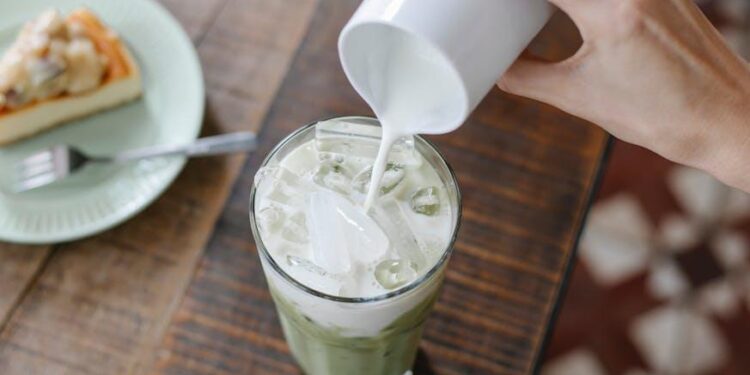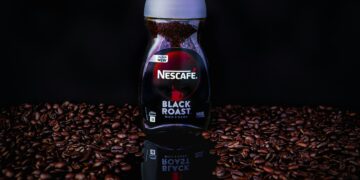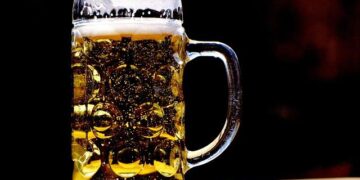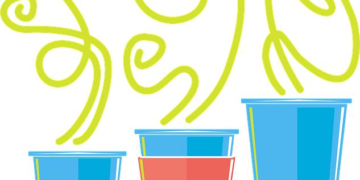Table of Contents
Introduction: The Question in Aisle Five
The journey begins in a familiar, almost archetypal modern setting: the fluorescent glare of a convenience store.
Here, against one wall, stands a monument to the 21st-century pace of life—a vast, colorful display of energy drinks, a veritable “wall of power.” The cans, emblazoned with aggressive logos and vibrant graphics, promise vitality, focus, and the endurance to conquer a demanding world.
Among them, one brand dominates with its iconic, claw-scratched ‘M’: Monster Energy.
Picking up the classic 16 fl oz black-and-green can, its cool weight feels substantial, purposeful.
This simple act triggers the central question of this investigation, a question that millions of consumers implicitly ask every day: “I know this gives you a ‘buzz,’ but what’s actually in here? How much caffeine are we really talking about?”.1
This is not a simple question with a simple answer.
It is the beginning of an inquiry, a detective story where the can itself is the first piece of evidence in a case that will prove to be far more complex than it appears.3
The investigation that follows will go beyond the numbers printed on the label to uncover the full story.
It is a journey into the chemical composition, the sprawling product portfolio, the physiological impact, and the calculated marketing that defines one of the world’s most popular energy drinks.
The initial question, prompted by the can in hand, is merely the “outcropping,” a visible clue that hints at a much deeper and more intricate phenomenon demanding to be explored.5
This report will follow the evidence, from the label on the can to the labs of medical researchers and the corridors of regulatory agencies, to assemble a complete dossier on the caffeinated heart of a Monster.
Section 1: Cracking the Code on the Classic Can
The investigation commences with the primary piece of evidence: the Nutrition Facts label on a standard 16 fl oz can of the original Monster Energy.
This document, often glanced at but rarely scrutinized, requires careful interpretation, much like a cryptic message at a crime scene.6
The most prominent clue is the caffeine content.
The label, and numerous supporting documents, explicitly state that a single 16 oz can contains 160 mg of caffeine.1
This translates to a concentration of approximately 10 mg of caffeine per fluid ounce (
mg/floz).10
This number is the headline figure, the starting point from which all other lines of inquiry will extend.
However, it is far from the only relevant piece of data.
The label also reveals a staggering
54 grams of sugar—with some sources listing it as high as 57 or 58 grams—and a calorie count of around 210 to 230.8
This sugar content is a critical finding, as the rapid influx of glucose contributes significantly to the initial “jolt” of energy and, just as importantly, to the subsequent crash.
This creates a physiological experience fundamentally different from that of caffeine consumed in isolation.12
A single number, however, remains meaningless without context.
A detective must compare it to known quantities to understand its true significance.
When placed alongside other common beverages, the 160 mg figure begins to reveal its complex character.
A 16 oz serving of Monster Energy contains roughly the same amount of caffeine as a similarly sized cup of brewed coffee, which can range from an average of 180 mg to well over 300 mg at a coffeehouse chain like Starbucks.11
An average 8 oz cup of home-brewed coffee, by contrast, contains closer to 100 mg.12
This comparison seems to place Monster within a familiar range of daily consumption, a point the beverage industry itself often highlights to normalize its products.18
Yet, this initial comparison is deceptive.
While the caffeine levels may be analogous, the overall composition is not.
Coffee contains caffeine and naturally occurring compounds; it does not contain 54 grams of added sugar or the proprietary blend of other stimulants found in a Monster.
The physiological response is therefore distinct.
The combination of high caffeine and a massive sugar load leads to a faster, more intense energy boost, but it also precipitates a more severe and rapid “crash,” with feelings of tiredness and lack of energy often setting in after only 60 to 90 minutes.12
The simple caffeine comparison, therefore, represents a critical oversimplification.
It creates an illusion of familiarity that masks the product’s unique metabolic impact.
The first clue—the label on the can—has already revealed that this case is about the intricate and potent
combination of its ingredients, not just a single active compound.
The investigation must go deeper.
Section 2: A Labyrinth of Flavors: Uncovering the Monster Portfolio
The initial focus on a single can proves to be a rookie mistake.
A return to the store cooler reveals the true scope of the challenge: Monster is not one product, but a sprawling, labyrinthine portfolio of over 50 distinct varieties.11
Each can, with its unique flavor and formulation, is another piece of the puzzle.
This discovery transforms the investigation from a simple analysis of a single item into a complex case of brand identity versus product reality.
The monolithic branding, unified by the iconic claw-mark logo, conceals a startling degree of variance that is a major source of consumer confusion and potential risk.
To understand the full picture, the evidence must be cataloged systematically.
A breakdown of Monster’s main product lines reveals a wide and often unpredictable spectrum of caffeine content.
- The Original Line (The Baseline): This category includes the flagship Original Green flavor, along with popular variants like Pipeline Punch. These products establish the brand’s baseline caffeine content, consistently containing 160 mg per 16 fl oz can.8
- Monster Ultra (The Lighter Hit): This widely popular zero-sugar line, recognizable by its textured white, blue, red, and other colored cans, contains slightly less caffeine. Flavors in the Ultra series typically range from 150 mg to 155 mg per 16 fl oz can.8
- Monster Zero Sugar (The Deceptive Twin): Often confused with the Ultra line, the “Zero Sugar” variant of the original green can is marketed as a healthier alternative. However, its caffeine content is nearly identical to its sugary counterpart, containing between 140 mg and 160 mg per can. This demonstrates that marketing focused on sugar reduction does not equate to a lower stimulant load.8
- Juice Monster (The Sweet Spot): This line blends energy drink ingredients with fruit juice. Flavors like Mango Loco and Khaos are also potent, hovering around 154 mg to 160 mg of caffeine per 16 fl oz can.26
- Rehab Monster (The “Recovery” Drink): Marketed with terms like “hydration” and “electrolytes,” this non-carbonated, tea-based line might be perceived as a less intense option. This perception is incorrect. The Rehab line contains a substantial 160 mg to 170 mg of caffeine per can, placing it on par with or even slightly above the original formula.25
- Java Monster (The Heavy Hitter): This is perhaps the most critical and alarming discovery in the product portfolio. The coffee-and-cream-based Java line represents a massive leap in potency. While some flavors like Mean Bean contain a formidable 170 mg to 188 mg of caffeine, the “Triple Shot” sub-line (with flavors like Mocha and French Vanilla) contains a staggering 300 mg of caffeine per 15 fl oz can.19 This single beverage contains 75% of the daily caffeine amount the U.S. Food and Drug Administration (FDA) recommends for a healthy adult.
- The Outliers: The investigation also uncovers the extreme ends of the spectrum. “Monster Unleaded” is a nearly caffeine-free option with less than 20 mg per can.11 At the other end, the resealable 24 oz “Mega Monster” can delivers a total of
240 mg of caffeine.11 Furthermore, the company has branched into alcoholic beverages with “The Beast Unleashed” line, which is entirely caffeine-free, adding another layer of potential brand confusion.32
To consolidate these disparate findings, the following evidence file is presented.
Table 1: Caffeine Content Across the Monster Energy Portfolio
| Monster Product Line | Specific Flavor Example | Can Size (fl oz) | Caffeine per Can (mg) | Caffeine per fl oz (mg) |
| Original | Original Green | 16 | 160 | 10.0 |
| Zero Sugar | Monster Zero Sugar | 16 | 140-160 | 8.8-10.0 |
| Ultra | Ultra White | 16 | 150 | 9.4 |
| Juice | Mango Loco | 16 | 160 | 10.0 |
| Rehab | Tea + Lemonade | 15.5 | 160 | 10.3 |
| Mega Monster | Original Green | 24 | 240 | 10.0 |
| Java Monster | Mean Bean | 15 | 188 | 12.5 |
| Java Monster | Triple Shot Mocha | 15 | 300 | 20.0 |
| Unleaded | Original Flavor | 16 | < 20 | < 1.3 |
Sources: 8
This systematic analysis reveals a crucial finding: brand generalization is perilous.
Monster Beverage Corporation markets its products under a powerful, unified brand identity, with a consistent logo, aesthetic, and association with extreme sports and high-octane lifestyles.33
This creates a brand halo effect, where a consumer’s experience with one product might be unconsciously generalized to the entire line.
A person who regularly drinks a Monster Ultra (150 mg) and feels fine might assume all Monster products are similar in potency.
This assumption is demonstrably false and dangerous.
That same consumer, grabbing a Java Monster Triple Shot by mistake, would be ingesting double the amount of caffeine they are accustomed to, an increase of 150 mg in a single serving.
This significant risk of accidental overconsumption is not a flaw in the product but a direct consequence of a marketing strategy that prioritizes a monolithic brand image over transparent product differentiation.
The investigation reveals that one cannot trust the brand name alone; each can must be treated as a separate case requiring individual scrutiny.
Section 3: Inside the “Energy Blend”: A Look Under the Hood
The investigation now proceeds to the most cryptic clue on the can: the “Energy Blend”.13
This phrase, listed among the ingredients, often represents a proprietary formula, meaning the exact quantities of its constituent parts are not disclosed to the consumer.
It is the “black box” of the case, a mixture of substances whose individual and combined effects are poorly understood by the public.
Deconstructing this blend requires moving from the nutrition label to the annals of scientific research.
- Caffeine (The Known Suspect): This is the primary active ingredient, the engine of the energy drink. While Monster does not always specify the source, energy drink manufacturers commonly use synthetic caffeine. It is chemically almost identical to naturally occurring caffeine but is cheaper to produce and is absorbed more quickly by the body, leading to a faster energy boost and, consequently, a faster crash.11
- Guarana (The Hidden Accomplice): The label lists guarana as a distinct ingredient, but this is misleading. Guarana is a plant native to the Amazon, and its seeds contain a high concentration of caffeine—about twice that of coffee beans by weight.36 One gram of guarana can contain approximately 40 mg of caffeine.37 Because companies are not always required to list the caffeine contribution from herbal ingredients like guarana, the total stimulant load of the drink can be higher than the number listed for “caffeine” alone. This practice adds a significant layer of obscurity, making it nearly impossible for a consumer to know the true dose of stimulants they are ingesting.38
- Taurine (The Controversial Partner): Taurine is an amino acid that is abundant in the human body, particularly in the brain and muscles. Monster’s official website claims it is essential for skeletal muscle function and helps protect the heart.35 However, the scientific consensus is far from clear. Some research suggests that taurine may actually have a calming or sedative effect on the central nervous system, potentially counteracting the jitteriness caused by high doses of caffeine.36 Other studies point to possible cardioprotective effects, while some raise concerns that combining taurine with caffeine could exacerbate cardiac stress and increase the risk of adverse events like arrhythmias.42 Crucially, a systematic review of energy drink ingredients found an overwhelming lack of evidence to support the claim that taurine, in the amounts provided, enhances physical or cognitive performance.44
- Panax Ginseng (The Herbal Element): This is another common ingredient touted for its purported benefits. Monster claims it aids in performance and reduces fatigue.35 Yet, much like taurine, the scientific evidence supporting these claims in the context of energy drinks is weak to nonexistent. Independent reviews have found no scientific basis for the efficacy of Panax ginseng for energy enhancement at the doses used in these beverages.44
- L-Carnitine (The Metabolic Agent): This amino acid plays a role in the body’s natural energy production by transporting fatty acids. The implication is that supplementing with it will boost this process.35 Once again, there is no robust scientific evidence to support claims that the amount of L-carnitine in an energy drink measurably improves endurance or fat metabolism.44
- B-Vitamins (The Overdose): The nutrition label on a can of Monster reveals massive doses of B-Vitamins—B2 (Riboflavin), B3 (Niacin), B6, and B12—often listed at several hundred or even several thousand percent of the recommended daily value (%DV).14 B-vitamins are essential nutrients that help the body convert food into energy. However, they are water-soluble, meaning the body does not store them; any excess is simply filtered by the kidneys and excreted in urine. The megadoses found in energy drinks serve little physiological purpose and are primarily a marketing tool to reinforce the “energy” claim. While generally considered safe, excessive intake of certain B-vitamins, particularly B6 and niacin, can lead to adverse effects, including skin conditions, gastrointestinal problems, blurred vision, and even nerve damage.48
The deconstruction of the “Energy Blend” leads to a sobering conclusion.
The blend appears to be more of a marketing construct than a scientifically-validated performance formula.
The primary psychoactive effects come from two well-understood ingredients: caffeine and sugar.
The other components—taurine, ginseng, L-carnitine—are largely “window dressing,” allowing for a host of marketing claims that are not supported by strong independent evidence.
The true danger of this proprietary blend may lie not in the negligible benefits of its individual ingredients, but in their unknown quantities and the potential for harmful synergistic interactions.
The term “Energy Blend” creates the impression of a sophisticated, multi-pronged approach to energy enhancement.
In reality, it is a black box that obscures the true nature of the product, prevents consumers from making a truly informed risk assessment, and may introduce unstudied health risks.
For instance, in vitro studies on human neuronal cells have suggested that the combination of caffeine, taurine, and guarana can promote apoptosis (cell death) by disrupting the cells’ natural antioxidant balance.50
Other research points to the combination exacerbating cardiovascular stress beyond what caffeine would do alone.43
The blend, therefore, is not just a list of ingredients; it is a veil of scientific-sounding terms that conceals a simple, potent, and potentially hazardous core.
Section 4: The Public Health File: A Trail of Adverse Events
The investigation now pivots from the chemical analysis of the can to the clinical consequences of its consumption.
If the ingredients are the “means” and the promise of energy is the “motive,” this section examines the “crime scene”—the documented harm to public health.
The tone here becomes more serious, grounded in the stark data from medical journals, public health agencies, and the tragic stories of those affected.
The evidence of a public health problem is substantial.
Emergency room visits related to energy drink consumption have skyrocketed in the United States, more than doubling from approximately 10,000 in 2007 to over 20,000 by 2011.8
A significant portion of these incidents involve adolescents and young adults, the primary demographic targeted by energy drink marketing.55
The symptoms reported in these ER visits and in medical literature paint a disturbing picture of the body under duress.
The adverse effects range from the commonly cited (anxiety, insomnia, severe headaches, heart palpitations, and gastrointestinal upset) to the life-threatening.50
More severe events documented in medical case reports include seizures, acute kidney injury, rhabdomyolysis (a dangerous breakdown of muscle tissue), cardiac arrest, and ischemic stroke.50
The investigation must focus on reports that specifically name the product in question.
The FDA has acknowledged receiving adverse event reports linking Monster Energy drinks to at least five deaths and one non-fatal heart attack between 2004 and 2012.54
While the FDA notes that such reports do not definitively prove causation, they represent a serious pattern of concern that warrants investigation.
Two specific case files are particularly illuminating:
- The Case of Anais Fournier: In December 2011, 14-year-old Anais Fournier died after drinking two 24-ounce cans of Monster Energy over a 24-hour period. Her total caffeine intake was approximately 480 mg. The autopsy report concluded her cause of death was “cardiac arrhythmia due to caffeine toxicity”.10 The medical examiner also found that she had a pre-existing, undiagnosed heart condition (Ehlers-Danlos syndrome) that can weaken blood vessels. Her family filed a wrongful death lawsuit, alleging that Monster failed to adequately warn consumers of the risks associated with its product.55 This case is critical as it highlights the extreme danger energy drinks pose to individuals with underlying health vulnerabilities, which are often unknown to the person themselves.
- The Case of Alex Morris: In 2013, the mother of 19-year-old Alex Morris filed a lawsuit against Monster Beverage Corporation. Morris had consumed at least two 16-ounce cans of Monster every day for the three years leading up to his death. He died of cardiac arrest, with the autopsy listing “cardiac arrhythmia due to cardiomyopathy” as the cause.61 This case points to the potential dangers of chronic, long-term consumption, even in young adults who may otherwise appear healthy.
This trail of adverse events has led to strong warnings from the highest levels of the medical and public health communities.
This “expert testimony” provides crucial context for the numbers.
- The U.S. Food and Drug Administration (FDA): Advises a general limit of 400 mg of caffeine per day for healthy adults.8 Consuming one Java Monster Triple Shot (300 mg) or two Original Monsters (320 mg) brings an adult perilously close to this daily limit. The FDA also notes that toxic effects, including seizures, can occur with the rapid consumption of around 1,200 mg of caffeine.59
- The American Academy of Pediatrics (AAP): The AAP’s position is unequivocal and damning for the industry. It states that “caffeine and other stimulant substances contained in energy drinks have no place in the diet of children and adolescents“.56 The AAP warns that caffeine can harm the still-developing cardiovascular and nervous systems of young people. This is a powerful indictment, given that adolescents are a core marketing demographic for Monster.
- The Centers for Disease Control and Prevention (CDC): The CDC echoes these concerns, highlighting dangers such as dehydration (as caffeine is a diuretic), heart complications like irregular heartbeat and heart failure, anxiety, and insomnia in students who consume energy drinks.65
To synthesize these findings into a clear risk assessment, the following table juxtaposes the caffeine content of Monster products against common beverages and official health limits.
It serves as the “rap sheet” in this investigation, starkly illustrating how easily consumption can cross into dangerous territory.
Table 2: Caffeine Context: Monster vs. Common Beverages and Official Health Limits
| Beverage | Serving Size (fl oz) | Caffeine (mg) |
| Coca-Cola | 12 | 34 |
| Brewed Coffee (Home) | 8 | ~100 |
| Red Bull | 8.4 | 80 |
| Monster Energy (Original) | 16 | 160 |
| Starbucks Brewed Coffee (Grande) | 16 | ~310 |
| Monster Mega | 24 | 240 |
| Java Monster Triple Shot | 15 | 300 |
| Bang Energy Drink | 16 | 300 |
| AAP Daily Limit (Adolescent) | N/A | < 100 |
| FDA Daily Limit (Adult) | N/A | < 400 |
Sources: 8
The evidence presented in this section reveals that energy drinks like Monster are not neutral products.
They act as a powerful vulnerability amplifier.
The case of Anais Fournier shows how they can turn a manageable, undiagnosed heart condition into a fatal one.10
Numerous reports show that when co-consumed with alcohol, the stimulant effects of caffeine mask the depressant effects of the alcohol.
This leads individuals to feel less intoxicated than they truly are, which in turn promotes risk-taking behaviors like binge drinking and driving under the influence.37
Furthermore, consumption in adolescents is linked to a constellation of other unhealthy habits, including poor mental health, sleep disruption, and other risk-seeking behaviors.48
The danger of Monster, therefore, is not just its isolated chemical composition, but its role as a catalyst that preys upon and exacerbates existing physiological and behavioral vulnerabilities, making it a significant public health concern that extends far beyond its direct caffeine toxicity.
Section 5: The System: Marketing, Regulation, and Willful Obscurity
The final stage of this investigation widens the scope from the product and its effects to the system that allows this situation to persist.
A detective must look beyond the immediate evidence to understand the context in which events occur.
The consumer confusion and public health issues surrounding Monster Energy are not accidental; they are the result of a system of calculated ambiguity built on regulatory loopholes, opaque labeling, and targeted marketing that prioritizes profit over public health transparency.
The foundation of this system is a crucial regulatory loophole.
For years, energy drinks were marketed not as “beverages” or “foods,” but as “dietary supplements”.36
This distinction is paramount.
The FDA strictly limits the amount of caffeine that can be in a soda to 71 mg per 12 oz.55
However, there is no such legal limit for products classified as dietary supplements.
This loophole was the primary mechanism that allowed the energy drink industry to flourish with products containing two, three, or even four times the caffeine of a traditional soft drink.70
In 2014, in response to mounting legal pressure and public scrutiny, Monster Beverage Corporation reclassified its products as beverages.48
While this was a significant move, the legacy of this initial unregulated environment continues to shape the market and consumer perception.
This regulatory ambiguity enables a labeling strategy that can only be described as a labyrinth for the average consumer.
As established, the use of “servings per container” on a can that is almost universally consumed in a single sitting can mislead consumers about the total caffeine, sugar, and calories they are ingesting.7
A study by
Consumer Reports found that nearly 40% of college students do not read energy drink labels, and a quarter of those say they don’t understand them.39
The use of proprietary “energy blends” is another key tactic of obfuscation, concealing the exact amounts of active ingredients like taurine and guarana and making a true risk assessment impossible.73
To compound the issue, independent testing has shown that the caffeine content listed on labels is not always accurate, with some drinks containing over 20% more caffeine than declared.74
This system of ambiguity is amplified by a powerful and sophisticated marketing machine.
Monster Beverage Corp. has masterfully cultivated a brand image that resonates with edginess, rebellion, and high performance, primarily targeting a young and adventurous demographic.33
The company pours millions into sponsoring extreme sports events like motocross and snowboarding, music festivals, and popular e-sports athletes and teams.33
This marketing is in direct and stark conflict with the explicit recommendations from the American Academy of Pediatrics and other leading health bodies that adolescents should not consume these products at all.65
Lawsuits have even accused Monster of marketing its products to children as young as six years old.61
The result is a system of calculated ambiguity.
The company exploits regulatory loopholes to formulate highly caffeinated products.
It uses confusing labeling practices that obscure the true contents and risks of those products.
It then markets those products aggressively to the very demographic that health experts have identified as the most vulnerable to their potential harm.
When confronted, the company’s public stance has been one of dismissal.
In response to questions from Consumer Reports about why the company does not clearly list caffeine amounts, a Monster official stated, “There is no legal or commercial business requirement to do so.
And because our products are completely safe, and the actual numbers are not meaningful to most consumers”.74
This statement is a telling piece of evidence.
It dismisses the fundamental principle of informed consent and suggests that the lack of clarity is not an oversight, but a feature.
The mystery of what is truly inside a can of Monster is not a puzzle for the consumer to solve; it is a state of confusion actively maintained by the manufacturer and enabled by a permissive regulatory environment.
Conclusion: The Verdict on a Simple Question
The investigation comes full circle, returning to the personal perspective in the convenience store.
The can of Monster, once a simple object of curiosity, is now an artifact loaded with complexity, controversy, and consequence.
The journey to answer a seemingly straightforward question has led through a maze of product variations, cryptic ingredient lists, alarming medical reports, and a system that seems designed to obscure rather than to clarify.
The simple question—”How much caffeine is in a Monster?”—now has a profoundly complex answer.
The answer is not simply “160 milligrams.”
The answer is:
- It depends entirely on which of the more than 50 varieties is chosen, a spectrum that ranges from a modest 140 mg to a shocking 300 mg, a dose that approaches the FDA’s recommended daily limit for an adult in a single can.
- It is a dose of caffeine that is supercharged with a massive load of sugar, creating a rapid, intense, and short-lived physiological experience that is fundamentally different from that of coffee.
- It is a dose of caffeine that is amplified by a proprietary and scientifically unproven “energy blend” of other stimulants and chemicals, whose synergistic effects on the human body are not fully understood and may pose additional risks.
- It is a dose that is aggressively and successfully marketed to the young and the vulnerable, in direct contradiction to explicit warnings from the entire pediatric medical establishment.
- It is a dose whose full contents and risks are systematically obscured from the consumer by a combination of regulatory loopholes and calculatedly ambiguous labeling.
The journey of discovery is complete.
The goal of this investigation was never to deliver a simplistic “good” or “bad” verdict, but to pursue the truth with the rigor of a detective.
The aim was to uncover, to understand, and to reveal the full context behind a ubiquitous product.
The case is now closed, not with a sentence, but with the empowerment of the reader.
Armed with this complete dossier—the evidence from the label, the data from the lab, the testimony from the medical community, and an understanding of the system at play—every consumer can now act as their own informed judge when they stand before the wall of power in aisle five.
Works cited
- Monster Energy Original – 12 – 16 Fl. Oz. – carrsqc, accessed August 7, 2025, https://www.carrsqc.com/shop/product-details.970028527.html
- Monster Energy Original – 4 – 16 Fl. Oz. – starmarket, accessed August 7, 2025, https://www.starmarket.com/shop/product-details.108100234.html
- Are We All Time-Travelling Detectives? Why Metaphors Matter in Talking About the Work Historians Do (Part 2), accessed August 7, 2025, https://gtw.hypotheses.org/8390
- a methodological metaphor – what detective are you? – Pat Thomson, accessed August 7, 2025, https://patthomson.net/2013/02/07/a-methodological-metaphor-what-detective-are-you/
- The researcher as detective: Another way of looking at professions and organizations, accessed August 7, 2025, https://www.researchgate.net/publication/345039589_The_researcher_as_detective_Another_way_of_looking_at_professions_and_organizations
- How To Read Food and Beverage Labels | National Institute on Aging, accessed August 7, 2025, https://www.nia.nih.gov/health/healthy-eating-nutrition-and-diet/how-read-food-and-beverage-labels
- How to Understand and Use the Nutrition Facts Label – FDA, accessed August 7, 2025, https://www.fda.gov/food/nutrition-facts-label/how-understand-and-use-nutrition-facts-label
- Monster Energy: Caffeine Content Explained – FreeRx.com, accessed August 7, 2025, https://freerx.com/Blog/Details?s=%09Monster%20Energy%3A%20Caffeine%20Content%20Explained%09
- Save on Monster Energy Drink Order Online Delivery | GIANT, accessed August 7, 2025, https://giantfoodstores.com/groceries/beverages/energy-drinks/monster-energy-drink-16-oz-can.html
- Monster Energy – Wikipedia, accessed August 7, 2025, https://en.wikipedia.org/wiki/Monster_Energy
- How Much Caffeine Is in Monster Energy Drinks? 2025 Breakdown | Corner Coffee Store, accessed August 7, 2025, https://cornercoffeestore.com/how-much-caffeine-is-in-monster-energy-drinks/
- What is the amount of caffeine present in Monster Energy Drinks? – Lifeboost Coffee, accessed August 7, 2025, https://lifeboostcoffee.com/blogs/lifeboost/what-is-the-amount-of-caffeine-present-in-monster-energy-drinks
- Monster Energy Original Energy Drink Can, 16 fl oz – Foods Co., accessed August 7, 2025, https://www.foodsco.net/p/monster-energy-original-energy-drink-can/0007084781116
- Monster Energy Green Original 16 oz Cans – Shop Sports & energy drinks at H-E-B, accessed August 7, 2025, https://www.heb.com/product-detail/monster-energy-green-original-16-oz-cans/690258
- How Much Caffeine Is In Coffee vs Tea vs Soda, accessed August 7, 2025, https://coffeebros.com/blogs/coffee/how-much-caffeine-is-in-coffee-vs-tea-vs-soda
- How much caffeine is in coffee, tea, soda, and other foods?, accessed August 7, 2025, https://www.cspi.org/article/how-much-caffeine-coffee-tea-soda-and-other-foods
- Coffee, Tea, Soft Drinks — Caffeine Content – Utah Math Department, accessed August 7, 2025, https://www.math.utah.edu/~yplee/fun/caffeine.html
- Knowing Your Energy Drink Ingredients – American Beverage Association, accessed August 7, 2025, https://www.americanbeverage.org/education-resources/blog/knowing-your-energy-drink-ingredients
- freerx.com, accessed August 7, 2025, https://freerx.com/Blog/Details?s=%09Monster%20Energy%3A%20Caffeine%20Content%20Explained%09#:~:text=Most%20Monster%20Energy%20drinks%20have,with%20less%20than%2020%20mg.
- How Much Caffeine Is in Monster Energy Ultra? 2025 Breakdown | Corner Coffee Store, accessed August 7, 2025, https://cornercoffeestore.com/how-much-caffeine-is-in-monster-energy-ultra/
- Monster Energy Ultra Sunrise Sugar Free Energy Drink – 12-16 Fl. Oz. – pavilions, accessed August 7, 2025, https://www.pavilions.com/shop/product-details.970066165.html
- www.monsterenergy.com, accessed August 7, 2025, https://www.monsterenergy.com/en-za/energy-drinks/monster-ultra/ultra-aka-the-white-monster/
- Monster Energy Ultra White – 500 mL – Energizing – Lolly’s, accessed August 7, 2025, https://lollys.fr/en/products/monster-energy-ultra-white
- How Much Caffeine Is in Monster Zero Sugar? 2025 Breakdown – Corner Coffee Store, accessed August 7, 2025, https://cornercoffeestore.com/how-much-caffeine-in-monster-zero-sugar/
- The Most Popular Canned Energy Drinks, Ranked by Caffeine Content | VinePair, accessed August 7, 2025, https://vinepair.com/articles/canned-energy-drinks-caffeine-content/
- Monster, Juice – Energy Drink, Khaos, 4 Pack (4 count) | Shop, accessed August 7, 2025, https://www.weismarkets.com/shop/product/monster-juice-energy-drink-khaos-4-pack/786478
- Juiced Monster Mango Loco, accessed August 7, 2025, https://www.monsterenergy.com/en-ie/energy-drinks/juiced-monster/mango-loco/
- Monster, Rehab – Strawberry Lemonade Energy Drink (15.5 fl oz), accessed August 7, 2025, https://shop.winndixie.com/shop/product/monster-rehab-strawberry-lemonade-energy-drink/2691645
- Rehab Monster Energy Drink, Tea + Lemonade | Publix Super Markets, accessed August 7, 2025, https://www.publix.com/pd/rehab-monster-energy-drink-tea–lemonade/RIO-PCI-175189
- www.kroger.com, accessed August 7, 2025, https://www.kroger.com/p/java-monster-mean-bean-coffee-energy-drink-can/0007084781260#:~:text=KILLER%20FLAVOR%3A%20Premium%20coffee%20and,or%20women%20who%20are%20nursing.
- Shopping Lists – Metcalfe’s West Towne – Java Monster Coffee + Energy Mean Bean Energy Drink, 15 Fl Oz (443 Ml), accessed August 7, 2025, https://www.shopmetcalfes.com/online/metcalfeswesttowne/shopping-lists?pid=5ce14aab-9619-4c09-82f2-ad20007a1440&productName=java-monster-energy-drink
- How Much Caffeine Is In Monster Energy’s Alcoholic Drinks? – Tasting Table, accessed August 7, 2025, https://www.tastingtable.com/1597563/monster-alcohol-drink-caffeine/
- Monster Beverage (MNST) Investor Relations Material – Quartr, accessed August 7, 2025, https://quartr.com/companies/monster-beverage-corporation_3807
- Monster, energy drink by Monster Energy Company – Nutrition Value, accessed August 7, 2025, https://www.nutritionvalue.org/Monster%2C_energy_drink_by_Monster_Energy_Company_1532456_nutritional_value.html
- Energy Drink Information, accessed August 7, 2025, https://www.monsterenergy.com/en-us/energy-drink-info/
- Energy Drinks – What You Don’t Know, accessed August 7, 2025, https://www1.villanova.edu/content/dam/villanova/studentlife/documents/healthpromotion/EnergyDrinks.pdf
- Nutrition and Health Info-Sheet, accessed August 7, 2025, https://nutrition.ucdavis.edu/sites/g/files/dgvnsk426/files/content/infosheets/fact-pro-energydrinks.pdf
- Energy Drinks | NCCIH – National Center for Complementary and Integrative Health, accessed August 7, 2025, https://www.nccih.nih.gov/health/energy-drinks
- Research: Students don’t read, understand energy drink labels – UIC College of Nursing, accessed August 7, 2025, https://nursing.uic.edu/news-stories/prof-finds-students-dont-read-understand-energy-drink-labels/
- Taurine Energy Drinks – News-Medical.net, accessed August 7, 2025, https://www.news-medical.net/health/Taurine-Energy-Drinks.aspx
- ELI5: What’s in energy drinks that provides the “kick” that one otherwise doesn’t get from coffee, tea, etc? – Reddit, accessed August 7, 2025, https://www.reddit.com/r/explainlikeimfive/comments/11mtpik/eli5_whats_in_energy_drinks_that_provides_the/
- Caffeine and Taurine from Energy Drinks—A Review – MDPI, accessed August 7, 2025, https://www.mdpi.com/2079-9284/11/1/12
- Taurine, Caffeine, and Energy Drinks: Reviewing the Risks to the Adolescent Brain – PMC, accessed August 7, 2025, https://pmc.ncbi.nlm.nih.gov/articles/PMC5737830/
- Energy Drink Ingredients and their Effect on Endothelial Function: A Review – Semantic Scholar, accessed August 7, 2025, https://pdfs.semanticscholar.org/7610/6b0019e44d48a7e5215c4cc7a0060e54239f.pdf
- Blends & botanicals: The ingredients for innovation in energy drinks, accessed August 7, 2025, https://www.innovamarketinsights.com/trends/blends-and-botanicals-energy-innovators-value-to-core-ingredients/
- Nutrition & Health Info Sheets for Consumers – Energy Drinks, accessed August 7, 2025, https://nutrition.ucdavis.edu/outreach/nutr-health-info-sheets/consumer-energy-drinks
- Prevalence and Amounts of Common Ingredients Found in Energy Drinks and Shots – PMC, accessed August 7, 2025, https://pmc.ncbi.nlm.nih.gov/articles/PMC8780606/
- Safety and Efficacy of Energy Drinks – Today’s Dietitian Magazine, accessed August 7, 2025, https://www.todaysdietitian.com/newarchives/0418p30.shtml
- Case Study: All Those Energy Drink Ingredients Add Up – IDEA Health & Fitness Association, accessed August 7, 2025, https://www.ideafit.com/case-study-all-those-energy-drink-ingredients-add-up/
- Energy Drink Consumption: Beneficial and Adverse Health Effects – PMC, accessed August 7, 2025, https://pmc.ncbi.nlm.nih.gov/articles/PMC4682602/
- Major Components of Energy Drinks (Caffeine, Taurine, and Guarana) Exert Cytotoxic Effects on Human Neuronal SH-SY5Y Cells by Decreasing Reactive Oxygen Species Production – PMC – PubMed Central, accessed August 7, 2025, https://pmc.ncbi.nlm.nih.gov/articles/PMC3674721/
- Major components of energy drinks (caffeine, taurine, and guarana) exert cytotoxic effects on human neuronal SH-SY5Y cells by decreasing reactive oxygen species production – PubMed, accessed August 7, 2025, https://pubmed.ncbi.nlm.nih.gov/23766861/
- Effects of energy drinks on the cardiovascular system – PMC – PubMed Central, accessed August 7, 2025, https://pmc.ncbi.nlm.nih.gov/articles/PMC5714807/
- FDA Posts Adverse Event Reports Related to Energy Drinks – NEJM Journal Watch, accessed August 7, 2025, https://www.jwatch.org/fw201211190000002/2012/11/19/fda-posts-adverse-event-reports-related-energy
- FDA has received reports of five people dying in recent years after drinking Monster Energy drinks, accessed August 7, 2025, https://www.hop-law.com/fda-has-received-reports-of-five-people-dying-in-recent-years-after-drinking-monster-energy-drinks/
- What’s the latest buzz on energy drinks? – Mayo Clinic Health System, accessed August 7, 2025, https://www.mayoclinichealthsystem.org/hometown-health/speaking-of-health/the-buzz-on-energy-drinks
- 7 Serious Side Effects of Drinking Energy Drinks Regularly – Verywell Health, accessed August 7, 2025, https://www.verywellhealth.com/what-do-energy-drinks-do-to-your-body-11780293
- Are Energy Drinks Bad for You? – Cleveland Clinic Health Essentials, accessed August 7, 2025, https://health.clevelandclinic.org/are-energy-drinks-bad-for-you
- Spilling the Beans: How Much Caffeine is Too Much? – FDA, accessed August 7, 2025, https://www.fda.gov/consumers/consumer-updates/spilling-beans-how-much-caffeine-too-much
- The Dark Side of Energy Drinks: A Comprehensive Review of Their Impact on the Human Body, accessed August 7, 2025, https://pmc.ncbi.nlm.nih.gov/articles/PMC10535526/
- Energy drink maker Monster sued for teen’s death – The Cochran Firm, accessed August 7, 2025, https://www.cochranfirm.com/washington-dc/energy-drink-maker-monster-sued-for-teens-death/
- FDA Investigating Reports Of Deaths Linked To Monster Energy Drink – CBS New York, accessed August 7, 2025, https://www.cbsnews.com/newyork/news/fda-investigating-reports-of-deaths-linked-to-monster-energy-drink/
- Monster Energy Drink Cited in Five Deaths | Manufacturing.net, accessed August 7, 2025, https://www.manufacturing.net/home/news/13141335/monster-energy-drink-cited-in-five-deaths
- www.mayoclinic.org, accessed August 7, 2025, https://www.mayoclinic.org/healthy-lifestyle/nutrition-and-healthy-eating/in-depth/caffeine/art-20045678
- The Buzz on Energy Drinks | School Nutrition – CDC, accessed August 7, 2025, https://www.cdc.gov/school-nutrition/energy-drinks/index.html
- The Shocking Truth About the Dangers of Energy Drinks – NFHS, accessed August 7, 2025, https://nfhs.org/stories/the-shocking-truth-about-the-dangers-of-energy-drinks
- How Much Caffeine? – Jackson Purchase Medical Center, accessed August 7, 2025, https://www.jacksonpurchase.com/news/how-much-caffeine
- Energy Drinks May Lead to Health Consequences – Piedmont Healthcare, accessed August 7, 2025, https://www.piedmont.org/living-real-change/energy-drinks-may-lead-to-serious-health-consequences
- For kids and teens, energy drinks may have harmful side effects – UCLA Health, accessed August 7, 2025, https://www.uclahealth.org/news/article/teens-energy-drinks-side-effects
- Energy Drinks • The Nutrition Source, accessed August 7, 2025, https://nutritionsource.hsph.harvard.edu/energy-drinks/
- The 4 Healthiest Energy Drinks, According to a Nutritionist | Food Network, accessed August 7, 2025, https://www.foodnetwork.com/healthyeats/healthy-tips/healthiest-energy-drinks
- FDA Energy Drink Regulation in the News: Health Experts Push for Regulatory Changes and Monster Moves to Market as a Beverage Instead of as a Dietary Supplement – – FIDJ Law, accessed August 7, 2025, https://fidjlaw.com/fda-energy-drink-regulation-in-the-news-health-experts-push-for-regulatory-changes-and-monster-moves-to-market-as-a-beverage-instead-of-as-a-dietary-supplement/
- ELI5: Why are energy drinks and the like so dangerous? : r/explainlikeimfive – Reddit, accessed August 7, 2025, https://www.reddit.com/r/explainlikeimfive/comments/1b13p2f/eli5_why_are_energy_drinks_and_the_like_so/
- Energy drink caffeine levels often stray from labels | Western Kentucky University, accessed August 7, 2025, https://www.wku.edu/news/articles/index.php?view=article&articleid=1740&return=archive
- Study Finds Energy Drink Caffeine Levels Differ from Labels, accessed August 7, 2025, https://www.schmidtlaw.com/study-finds-energy-drink-caffeine-levels-differ-from-labels/
- Report confronts energy beverage makers over labeling marketing practices, accessed August 7, 2025, https://www.foodbusinessnews.net/articles/2150-report-confronts-energy-beverage-makers-over-labeling-marketing-practices






